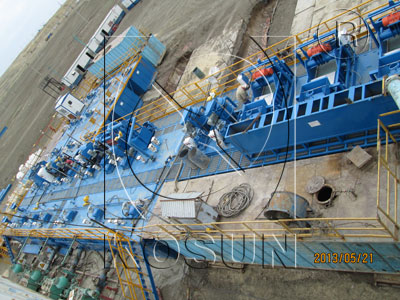Feb 11, 2014
In terms of functions, drilling fluids can be categorized into such two groups as useful solids, which contain barite, chemical agents, bentonites, etc. and harmful solids, for instance, drill cuttings, coarse bentonites, silt, etc. Drilling fluids solids control is defined as the technology used to fulfill the demands on mud properties by removing the harmful solids and keeping the useful solids. The latest development of drilling technology increases its demands on mud properties. It has been proved that it takes a complete set of suitable solids control equipment to improve that via controlling the solid content in drilling fluids, which guarantees the good performance of drilling fluids for a long time.
All of the drilling operators wish to own premium drilling fluids since it can enhance drilling facilities and allow them to drill fast and safely. Mere chemical treatment cannot ensure a stable performance of drilling fluids, though at a considerable cost. It will also take effective mechanical treatment equipment to control its solids content ( in fact, water usually works together with mechanical treatment for better effects ). Thus, mechanical solids control is both an essential process in mud performance maintenance and a constituent of normal drilling technology.

In drilling fluids, the solid particles exerting greatest influence on its performance and mechanical drilling speed are mostly more than 15μm in diameter. They account for 70% of all solid phase. It is popular pursuit that effective mechanical equipment can remove them at any time.
Solids control is a technique used in drilling rig to separate the solids in the drilling fluids that are crushed by the drill bits and carried out of the well surface. Normally solids control system is consist of five stages, including mud tank, shale shaker, vacuum degasser, desander, desilter, centrifuge. Shale shaker is used to separate the big solids with diameter above 75μm, and 45~74μm for desander, and 15~44μm for desilter. Sometimes desander & desilter are combined as high efficient mud cleaner. When air enters into the drilling fluids, vacuum degasser is used to separate the air. If no air is found in the mud, the degasser will work as a big agitator. All these equipment are mounted on the top of the mud tank. After separating the solids, the clean mud will be pumped into the borehole again.
It is an important measure to apply solids control equipment in optimization of well drilling. And it is necessary for scientific drilling to well control the solid content in the mud. Proper solids control can protect oil/gas bed, decrease drilling torque and friction, reduce the pressure wave of annulus pumping, prevent sticking caused by differential pressure, increase drilling speed, extend service life of drilling bit, minimize abrasion on equipment and tubes, prolong the lifespan of wear parts in drilling fluids circulating system, stabilize the boreholes, improve casing conditions, lessen environmental pollution, lower the expenses on drilling fluids, etc. Statistics show that 1% decrease of solid content ( that is, drilling fluids density reduce 0.01 ) in the mud will result in the increase in soft soil mechanical drilling by 8% or so. Accordingly, it will bring remarkable benefits if solids control is well performed.
In a word, people become increasingly aware of the significance of solids control equipment since it has directly influenced the safe, excellent and efficient drilling as well as protection of oil/gas bed.